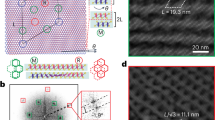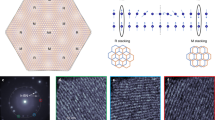Abstract
Twist engineering—the alignment of two-dimensional (2D) crystalline layers with a specific orientation—has led to tremendous success in controlling the charge degree of freedom, particularly in producing correlated and topological electronic phases in moiré crystals1,2. However, although pioneering theoretical efforts have predicted that non-trivial magnetism3,4,5 and magnons6,7 can be made by twisting 2D magnets, the experimental realization of engineering the spin degree of freedom by twisting remains elusive. Here we fabricate twisted double bilayers of a 2D magnet, namely, chromium triiodide (CrI3), and demonstrate the successful twist engineering of 2D magnetism in them. We identify signatures of a new magnetic ground state that is distinct from those in natural two-layer (2L) and four-layer (4L) CrI3. We show that for a very small twist angle, this emergent magnetism can be well approximated by a weighted linear superposition of those of 2L and 4L CrI3, whereas for a large twist angle, it mostly resembles that of isolated 2L CrI3. However, at an intermediate twist angle, there is a finite net magnetization that cannot be simply inferred from any homogeneous stacking configuration, but emerges because spin frustrations are introduced by competition between ferromagnetic and antiferromagnetic exchange coupling within individual moiré supercells.
This is a preview of subscription content, access via your institution
Access options
Access Nature and 54 other Nature Portfolio journals
Get Nature+, our best-value online-access subscription
$29.99 / 30 days
cancel any time
Subscribe to this journal
Receive 12 print issues and online access
$209.00 per year
only $17.42 per issue
Buy this article
- Purchase on Springer Link
- Instant access to full article PDF
Prices may be subject to local taxes which are calculated during checkout




Similar content being viewed by others
Data availability
Source data are provided with this paper. All other data that support the plots within this paper and other findings of this study are available from the corresponding authors upon reasonable request.
References
Balents, L., Dean, C. R., Efetov, D. K. & Young, A. F. Superconductivity and strong correlations in moiré flat bands. Nat. Phys. 16, 725–733 (2020).
Kennes, D. M. et al. Moiré heterostructures as a condensed-matter quantum simulator. Nat. Phys. 17, 155–163 (2021).
Hejazi, K., Luo, Z.-X. & Balents, L. Noncollinear phases in moiré magnets. Proc. Natl Acad. Sci. USA 117, 10721–10726 (2020).
Tong, Q., Liu, F., Xiao, J. & Yao, W. Skyrmions in the moiré of van der Waals 2D magnets. Nano Lett. 18, 7194–7199 (2018).
Hejazi, K., Luo, Z.-X. & Balents, L. Heterobilayer moiré magnets: moiré skyrmions and commensurate-incommensurate transitions. Phys. Rev. B 104, L100406 (2021).
Wang, C., Gao, Y., Lv, H., Xu, X. & Xiao, D. Stacking domain wall magnons in twisted van der waals magnets. Phys. Rev. Lett. 125, 247201 (2020).
Li, Y. H. & Cheng, R. Moiré magnons in twisted bilayer magnets with collinear order. Phys. Rev. B 102, 094404 (2020).
Cao, Y. et al. Correlated insulator behaviour at half-filling in magic-angle graphene superlattices. Nature 556, 80–84 (2018).
Cao, Y. et al. Unconventional superconductivity in magic-angle graphene superlattices. Nature 556, 43–50 (2018).
Regan, E. C. et al. Mott and generalized Wigner crystal states in WSe2/WS2 moiré superlattices. Nature 579, 359–363 (2020).
Tang, Y. et al. Simulation of Hubbard model physics in WSe2/WS2 moiré superlattices. Nature 579, 353–358 (2020).
Nuckolls, K. P. et al. Strongly correlated Chern insulators in magic-angle twisted bilayer graphene. Nature 588, 610–615 (2020).
Wu, S., Zhang, Z., Watanabe, K., Taniguchi, T. & Andrei, E. Y. Chern insulators, van Hove singularities and topological flat bands in magic-angle twisted bilayer graphene. Nat. Mater. 20, 488–494 (2021).
Chen, G. et al. Tunable correlated Chern insulator and ferromagnetism in a moiré superlattice. Nature 579, 56–61 (2020).
Tran, K. et al. Evidence for moiré excitons in van der Waals heterostructures. Nature 567, 71–75 (2019).
Jin, C. et al. Observation of moiré excitons in WSe2/WS2 heterostructure superlattices. Nature 567, 76–80 (2019).
Wang, J. et al. Optical generation of high carrier densities in 2D semiconductor heterobilayers. Sci. Adv. 5, eaax0145 (2019).
Seyler, K. L. et al. Signatures of moiré-trapped valley excitons in MoSe2/WSe2 heterobilayers. Nature 567, 66–70 (2019).
Yoo, H. et al. Atomic and electronic reconstruction at the van der Waals interface in twisted bilayer graphene. Nat. Mater. 18, 448–453 (2019).
Weston, A. et al. Atomic reconstruction in twisted bilayers of transition metal dichalcogenides. Nat. Nanotechnol. 15, 592–597 (2020).
Quan, J. et al. Phonon renormalization in reconstructed MoS2 moiré superlattices. Nat. Mater. 20, 1100–1105 (2021).
Lin, M.-L. et al. Moiré phonons in twisted bilayer MoS2. ACS Nano 12, 8770–8780 (2018).
Burch, K. S., Mandrus, D. & Park, J.-G. Magnetism in two-dimensional van der Waals materials. Nature 563, 47–52 (2018).
Huang, B. et al. Layer-dependent ferromagnetism in a van der Waals crystal down to the monolayer limit. Nature 546, 270–273 (2017).
Chen, W. et al. Direct observation of van der Waals stacking–dependent interlayer magnetism. Science 366, 983–987 (2019).
Kim, H. H. et al. Evolution of interlayer and intralayer magnetism in three atomically thin chromium trihalides. Proc. Natl Acad. Sci. USA 116, 11131–11136 (2019).
Jin, W. et al. Observation of the polaronic character of excitons in a two-dimensional semiconducting magnet CrI3. Nat. Commun. 11, 4780 (2020).
Li, S. et al. Magnetic-field-induced quantum phase transitions in a van der Waals magnet. Phys. Rev. 10, 011075 (2020).
Jiang, S., Li, L., Wang, Z., Mak, K. F. & Shan, J. Controlling magnetism in 2D CrI3 by electrostatic doping. Nat. Nanotechnol. 13, 549–553 (2018).
Huang, B. et al. Electrical control of 2D magnetism in bilayer CrI3. Nat. Nanotechnol. 13, 544–548 (2018).
Jiang, S., Shan, J. & Mak, K. F. Electric-field switching of two-dimensional van der Waals magnets. Nat. Mater. 17, 406–410 (2018).
Li, T. et al. Pressure-controlled interlayer magnetism in atomically thin CrI3. Nat. Mater. 18, 1303–1308 (2019).
Song, T. et al. Switching 2D magnetic states via pressure tuning of layer stacking. Nat. Mater. 18, 1298–1302 (2019).
Sivadas, N., Okamoto, S., Xu, X., Fennie, C. J. & Xiao, D. Stacking-dependent magnetism in bilayer CrI3. Nano Lett. 18, 7658–7664 (2018).
Jin, W. et al. Tunable layered-magnetism–assisted magneto-Raman effect in a two-dimensional magnet CrI3. Proc. Natl Acad. Sci. USA 117, 24664–24669 (2020).
Jin, W. et al. Raman fingerprint of two terahertz spin wave branches in a two-dimensional honeycomb Ising ferromagnet. Nat. Commun. 9, 5122 (2018).
Huang, B. et al. Tuning inelastic light scattering via symmetry control in the two-dimensional magnet CrI3. Nat. Nanotechnol. 15, 212–216 (2020).
Zhang, Y. et al. Magnetic order-induced polarization anomaly of Raman scattering in 2D magnet CrI3. Nano Lett. 20, 729–734 (2020).
McCreary, A. et al. Distinct magneto-Raman signatures of spin-flip phase transitions in CrI3. Nat. Commun. 11, 3879 (2020).
Jin, W. et al. Observation of a ferro-rotational order coupled with second-order nonlinear optical fields. Nat. Phys. 16, 42–46 (2020).
Casola, F., van der Sar, T. & Yacoby, A. Probing condensed matter physics with magnetometry based on nitrogen-vacancy centres in diamond. Nat. Rev. Mater. 3, 17088 (2018).
Wernsdorfer, W. From micro- to nano-SQUIDs: applications to nanomagnetism. Supercond. Sci. Technol. 22, 064013 (2009).
van der Laan, G. & Figueroa, A. I. X-ray magnetic circular dichroism—a versatile tool to study magnetism. Coord. Chem. Rev. 277–278, 95–129 (2014).
Acknowledgements
L.Z. acknowledges support by NSF CAREER grant no. DMR-174774 and AFOSR YIP grant no. FA9550-21-1-0065. R. He acknowledges support by NSF CAREER grant no. DMR-1760668. K.S. acknowledges support by NSF grant no. NSF-EFMA-1741618. R. Hovden acknowledges support from the W. M. Keck Foundation. This work made use of facilities at the Michigan Center for Materials Characterization. H.L. acknowledges support by the National Key R&D Program of China (grant nos. 2018YFE0202600 and 2016YFA0300504), the National Natural Science Foundation of China (nos. 11774423 and 11822412), the Beijing Natural Science Foundation (grant no. Z200005), and the Fundamental Research Funds for the Central Universities and Research Funds of Renmin University of China (RUC) (grant nos. 18XNLG14, 19XNLG17 and 20XNH062).
Author information
Authors and Affiliations
Contributions
L.Z., H.X. and X.L. conceived the idea and initiated this project. H.X. fabricated the 4L and 2L CrI3 and tDB CrI3 homostructures. H.X., X.L., G.Y., Z.Y. and H.G. carried out the Raman experiments under the supervision of L.Z. and R. He. S.H.S., E.R. and R. Hovden performed the TEM characterizations. S.Y., Y.F., S.T. and H.L. grew the van der Waals CrI3 bulk single crystals. K.S. performed the theoretical analysis. H.X., X.L., R. He and L.Z. analysed the data and wrote the manuscript. All the authors participated in the discussion of the results.
Corresponding authors
Ethics declarations
Competing interests
The authors declare no competing interests.
Additional information
Peer review information Nature Physics thanks the anonymous reviewers for their contribution to the peer review of this work
Publisher’s note Springer Nature remains neutral with regard to jurisdictional claims in published maps and institutional affiliations.
Supplementary information
Supplementary Information
Supplementary Figs. 1–4 and Sections 1–4.
Source data
Source Data Fig. 1
Statistical source data.
Source Data Fig. 2
Statistical source data.
Source Data Fig. 3
Statistical source data.
Source Data Fig. 4
Statistical source data.
Rights and permissions
About this article
Cite this article
Xie, H., Luo, X., Ye, G. et al. Twist engineering of the two-dimensional magnetism in double bilayer chromium triiodide homostructures. Nat. Phys. 18, 30–36 (2022). https://doi.org/10.1038/s41567-021-01408-8
Received:
Accepted:
Published:
Issue Date:
DOI: https://doi.org/10.1038/s41567-021-01408-8
This article is cited by
-
Multistep magnetization switching in orthogonally twisted ferromagnetic monolayers
Nature Materials (2024)
-
Controlled alignment of supermoiré lattice in double-aligned graphene heterostructures
Nature Communications (2023)
-
Revealing intrinsic domains and fluctuations of moiré magnetism by a wide-field quantum microscope
Nature Communications (2023)
-
Evidence of non-collinear spin texture in magnetic moiré superlattices
Nature Physics (2023)
-
Electrically tunable moiré magnetism in twisted double bilayers of chromium triiodide
Nature Electronics (2023)



